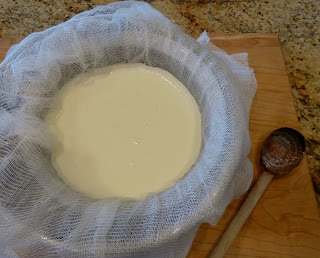Two Years Ago: Sesame Salmon en Papillote
I gave myself a challenge recently to make cannelloni from scratch - cooking the spinach, making the ricotta, and using fresh pasta sheets. I found fresh pasta sheets at my local upscale grocer, or you can often find them in Italian markets. The other alternative if you don't want to make your own pasta is to use no-boil lasagna noodles (Barilla brand has a texture closest to delicate fresh pasta). Why not use cannelloni or manicotta tubes out of a box? Because they're thick and chewy and nothing like delicate fresh pasta.
Anyway, it was an interesting afternoon project but I wouldn't try it on a week night. I started by making the filling which involved making fresh homemade ricotta, which only took about 90 minutes. If you can find high-quality fresh ricotta locally (try the Italian markets) you could skip this step, but it was really easy. Just don't use the chalky watery stuff from the grocery store. Then I cooked mature spinach leaves rather than baby spinach because they have more flavor and don't cook down into a slimy mess like baby spinach tends to.
After making the filling, I briefly cooked the pasta sheets and assembled the cannelloni, then made the bechamel sauce. Finally the bechamel, marinara, cannelloni and parmesan all went into the baking dish and then into the oven. (I used two smaller baking dishes rather than one large one because I wanted to freeze half for later.)
The end product was a very delicate and tender pasta with a beautiful soft filling. The dish definitely tasted like something you'd get at a restaurant. If you enjoy really good Italian food or like a challenge, this is a fun recipe to try. And if you already make your own pasta, this would be a great addition to your recipe collection.
Spinach and Ricotta Cannelloni
Serves 4
1 pound mature spinach leaves
7 ounces fresh ricotta cheese
1 large egg, lightly beaten
12 tablespoons grated Parmigiano-Reggiano cheese, divided
Kosher salt
Pinch freshly grated nutmeg
8 pieces of fresh pasta (approx 4” x 5”) or 8 no-boil
lasagna noodles (preferably Barilla)
1 tablespoon unsalted butter
3 cups marinara or simple tomato sauce
For the béchamel sauce
2 tablespoons unsalted butter
3 tablespoons all-purpose flour
2 cups whole milk, slightly warm or at room temperature
Pinch of ground nutmeg
Pinch of pepper
Kosher salt
Preheat oven to 425d.
Wash spinach well, discard stems, and cook covered over
medium heat in a large pot for about 10 minutes, using only the water remaining
on the leaves after washing. Stir
occasionally. Drain well in a fine-mesh
strainer, then place in a clean kitchen towel and squeeze out as much water as
possible. Finely chop the spinach and
place in a medium bowl. Add the ricotta,
egg, 8 tablespoons grated parmesan, salt and nutmeg. Mix well to combine.
If using fresh pasta sheets, cook for 1 minute in boiling
salted water; if using no-boil lasagna noodles, cook for 2 minutes or until
flexible. For either type of pasta,
drain and immediately submerge in cold water; let sit for a few minutes, then
remove and let dry on a clean kitchen towel in a single layer. If necessary, cut the pasta sheets to the
right size.
Meanwhile, make the béchamel sauce: melt butter in a saucepan over low heat. With a wire whisk, whisk flour into the
melted butter. Continue cooking over low
heat, whisking continuously, for 2-3 minutes.
Slowly pour in the milk while whisking continuously to prevent lumps.
(If a few lumps form, continue whisking and they should dissolve.) Season with nutmeg, pepper, and 1/2 teaspoon salt. Raise the heat to medium and continue
whisking until the mixture thickens, about 5-7 minutes. Taste and adjust seasonings; remove from the
heat, cover and keep warm.
Place a spoonful of filling across one of the short ends
of each pasta sheet and roll up to form a tube. Spray a baking dish (big enough to hold the
cannelloni in a single layer) with non-stick spray. Spoon one ladle of béchamel into the dish and
spread evenly over the bottom, then add a ladle of marinara or tomato
sauce. Place the cannelloni in the
baking dish, cover with the remaining marinara and béchamel and then sprinkle
with the remaining 4 tablespoons of parmesan.
Dot the top with the tablespoon of unsalted butter.
Bake until golden brown, about 15 – 20 minutes.














